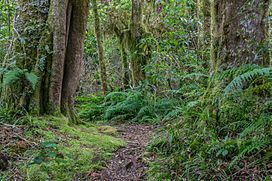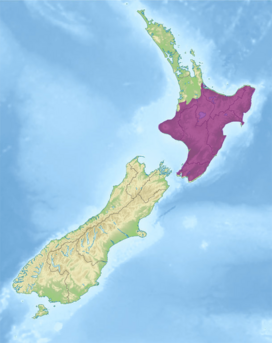North Island temperate forests facts for kids
Quick facts for kids North Island temperate forests |
|
|---|---|

Egmont National Park
|
|

Ecoregion territory (in purple)
|
|
| Ecology | |
| Realm | Australasian |
| Biome | temperate broadleaf and mixed forests |
| Borders | Northland temperate kauri forests |
| Geography | |
| Area | 84,041 km2 (32,448 sq mi) |
| Country | New Zealand |
| Regions | Bay of Plenty, Gisborne, Hawke's Bay, Manawatū-Whanganui, Taranaki, Waikato, and Wellington |
| Coordinates | 39°00′S 176°06′E / 39°S 176.1°E |
| Conservation | |
| Protected | 16,274 km² (19%) |
The North Island temperate forests are a special type of forest found on New Zealand’s North Island. They are known as a temperate broadleaf and mixed forest ecoregion. This means they are a large area with a specific climate, plants, and animals.
Contents
What is the North Island Temperate Forest Ecoregion?
This ecoregion covers most of the North Island of New Zealand. It stretches from the sea all the way up to tall volcanic mountains. The very northern part of the island, like the Northland Peninsula, has a different type of forest. That area is called the Northland temperate kauri forests ecoregion.
Mountains and Lakes
In the middle of the North Island is the North Island Volcanic Plateau. This area has many volcanoes. Lake Taupo, New Zealand's biggest lake, sits in a huge bowl. This bowl was made by a massive volcanic eruption about 2,000 years ago.
South of Lake Taupo, you'll find tall volcanic peaks. These include Mount Tongariro, Mount Ngauruhoe, and Mount Ruapehu. Much of this plateau is covered in old lava flows and volcanic ash.
Mount Taranaki is another active volcano. It is located on the west side of the island, near the coast.
Coastal Areas and Other Mountains
Along the east coast, there's a chain of mountains. These include the Tararua Range and the Kaimanawa Range. These mountains are mostly made of a type of rock called greywacke. This is different from the volcanic rocks found on the plateau.
There are also flat coastal areas along the eastern, western, and northern parts of the island.
Plants of the North Island Forests
The forests here have many unique trees.
Lowland Forests
In the lower areas, you'll see tall podocarp trees like rimu and mataī. These trees stand above a layer of evergreen trees. Some of these evergreen trees include kamahi and tawa.
Middle and High Elevation Forests
Higher up on the volcanic plateau, podocarp trees are still common. Here you might find rimu, miro, mataī, totara, and kahikatea. On Mount Taranaki, you can see Hall's totara and kaikawaka.
Even higher up, you'll find forests of southern beech trees. There are also areas of tussock grasslands. Near the treeline, where trees stop growing, you'll see shrubs like leatherwoods. Their tough leaves help them survive strong mountain winds. Above the treeline, there are mostly tussock grasslands.
Animals of the North Island Forests
This ecoregion is home to several special animals that are now rare.
Unique Wildlife
- The North Island brown kiwi is a flightless bird.
- The lesser short-tailed bat is a unique native bat.
- The North Island kōkako is a beautiful native bird.
Reptiles
Native reptiles include:
Protecting the North Island Forests
Sadly, most of the original forests in this area are gone. In the lowlands, much of the forest has been cleared for farms. On the plateau, it has been replaced by pastures and large farms growing radiata pine trees. These pine trees were brought from California a long time ago.
Past Threats to Wildlife
Before humans arrived in New Zealand, birds were the largest land animals. The only land mammals were bats. This ecoregion used to have huge flightless birds called moa. There were also large birds like Haast's eagle, the flightless New Zealand swan, and the North Island goose.
The Māori were the first humans to settle in New Zealand around 1280. They hunted many of the large birds, including the moa, swans, and geese, until they became extinct. The Māori also brought the Polynesian rat with them.
Modern Threats to Wildlife
Europeans settled in the 1800s. They brought more animals that caused problems for native wildlife. These included:
These new animals hunted many native birds and insects. Some of these native species now only survive on small islands where these new predators are not found.
Other introduced animals, like goats and Common brushtail possums, also cause harm. Possums eat a lot of leaves in the forests, damaging trees like kamahi, rata, kaikawaka, and Hall’s totara.
Protected Areas
About 19% of this ecoregion is now protected. This means these areas are set aside to keep nature safe. Some important protected places include:
- Tongariro National Park on the volcanic plateau.
- Egmont National Park, which protects Mount Taranaki.
- Whanganui National Park on the western side of the plateau.
- Te Urewera in the eastern highlands.
- Tararua Forest Conservation Park in the south.
See also
 In Spanish: Bosques templados de la Isla Norte para niños
In Spanish: Bosques templados de la Isla Norte para niños

